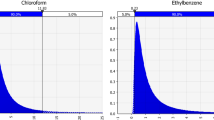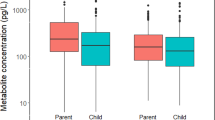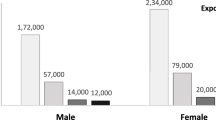Abstract
Toluene diisocyanate (TDI) is a well-known cause of occupational asthma, but we know little about the potential for exposure and health effects among residents who live near facilities that release TDI. In the mid-1990's, the North Carolina Department of Health and Human Services and the Agency for Toxic Substances and Disease Registry investigated exposures to TDI and health outcomes in one community, which left some unanswered questions. This cross-sectional study evaluated the potential associations between living near a TDI source and the prevalence of three variables: asthma or asthma-like respiratory symptoms, antibodies specific to TDI, and verifiable levels of TDI in residential air. Results among North Carolina residents living near such facilities (five target communities) were compared with the results from residents living further away (five comparison communities). Overall, the prevalence of reporting either asthma or asthma-like respiratory symptoms was higher (odds ratio=1.60; 95% confidence interval=0.97–2.54) among residents in target communities than those in comparison communities. However, this difference was not statistically significant. Symptom prevalence varied greatly among the community populations. The prevalence of respiratory symptoms was higher near facilities with historically higher TDI emissions. Among the 351 participants who provided blood samples, only one had immunoglobulin G specific antibodies to TDI. This participant lived in a target area and may have had non-occupational exposure. TDI was detected at an extremely low level (1 ppt) in one of the 45 air samples from target communities. One ppt is one-tenth the EPA reference concentration. Overall, air sample and antibody test results are not consistent with recent or ongoing exposure to TDI.
This is a preview of subscription content, access via your institution
Access options
Subscribe to this journal
Receive 6 print issues and online access
$259.00 per year
only $43.17 per issue
Buy this article
- Purchase on Springer Link
- Instant access to full article PDF
Prices may be subject to local taxes which are calculated during checkout
Similar content being viewed by others
Abbreviations
- CI:
-
confidence interval
- HDI:
-
hexamethylene diisocyanate
- IgE:
-
immunoglobulin E
- IgG:
-
immunoglobulin G
- LC-MS-MS:
-
liquid chromatography, mass spectrometry, mass spectrometry
- LOD:
-
limit of detection
- MDI:
-
diphenylmethane diisocyanate
- OR:
-
odds ratio
- ppb:
-
parts per billion
- ppt:
-
part per trillion
- TDI:
-
toluene diisocyanate
- TRI:
-
Toxic Release Inventory
References
Abramson M.J., Hensley M.J., Saunders N.A., and Wlodarczyk J.H. Evaluation of a new asthma questionnaire. J Asthma 1991: 28: 129–139.
American Anthropological Association. A Brief History of the OMB Directive 15. Available: http://www.aaanet.org/gvt/ombdraft.htm. (Retrieved 18 May 2007) 1997.
ATSDR (Agency for Toxic Substances and Disease Registry). Public Health Advisory for Trinity American Corporation. U.S. Department of Health and Human Services, Atlanta, US, 1997a.
ATSDR (Agency for Toxic Substances and Disease Registry). Health Consultation for the Trinity American Corporation. U.S. Department of Health and Human Services, Atlanta, GA, 1997b.
ATSDR (Agency for Toxic Substances and Disease Registry). Exposure Investigation for the Trinity American Corporation. U.S. Department of Health and Human Services, Atlanta, GA, 1998.
Baur X., Seemann U., Marczynski B., Chen Z., and Raulf-Heimsoth M. Humoral and cellular immune responses in asthmatic isocyanate workers: report of two cases. Am J of Ind Med 1996: 29: 467–473.
Bernstein D.I., Ott M.G., Woodhiser M., Lummus Z., and Graham C. Evaluation of antibody binding to diisocyanate protein conjugate in a general population. Ann Allergy Asthma Immunol 2006: 97: 357–364.
Burney P., and Chinn S. Developing a new questionnaire for measuring the prevalence and distribution of asthma. Chest 1987: 91: 79S–83S.
Burney P.G., Chinn S., Britton J.R., Tattersfield A.E., and Papacosta A.O. What symptoms predict the bronchial response to histamine? Evaluation in a community survey of the bronchial symptoms questionnaire (1984) of the International Union Against Tuberculosis and Lung Disease. Int J Epidemiol 1989: 18: 165–173.
Campo P., Wisnewski A.V., Lummus Z., Cartier A., Malo J.-L., Boulet L.P., and Bernstein D.I. Diisocyanate conjugate and immunoassay characteristics influence detection of specific antibodies in HDI-exposed workers. Clin Exp Allergy 2007: 37: 1095–1102.
CDC. Community exposure to toluene diisocyanate from a polyurethane foam manufacturing plant—North Carolina, 1997. MMWR 1998: 47: 455–457.
Darcey D., Lipscomb H., Epling C., Pate W., Cherry L., and Bernstein J. Clinical findings for residents near a polyurethane foam manufacturing plant. Arch Environ Health 2002: 57: 239–246.
Keskinen H., Tupasela O., Tiikkainen U., and Nordman H. Experiences of specific IgE in asthma due to diisocyanates. Clin Allergy 1988: 18: 597–604.
Malo J.-L., L’Archeveque J., Lummus Z., and Bernstein D. Changes in specific IgE and IgG and monocyte chemoattractant protein-1 in workers with occupational asthma caused by diisocyanates and removed from exposure. J Allergy Clin Immunol 2006: 118: 530–533.
NIOSH (National Institute for Occupational Safety and Health). Manual of Analytical Methods (NMAM), 4th edn. ISOCYANATES, TOTAL (MAP): METHOD 5525, 1, 2003.
North Carolina Department of Natural and Environmental Resources (NCDNER), Division of Air Quality (DAQ). Summary of the toxicity assessment of toluene diisocyanate conducted by the Secretary's Scientific Advisory Board on Toxic Air Pollutants, 1997: http://daq.state.nc.us/toxics/risk/sab/ra/tdisumm.shtml.
Orloff K., Batt-Osborne D., Kilgus T., Metcalf S., and Cooper M. Antibodies to toluene diisocyanate in an environmentally exposed population. Environ Health Perspect 1998: 106: 665–666.
Park H.-S., Lee S.K., Lee Y.M., Kim S.S., and Nahm D.H. Longitudinal study of specific antibodies to toluene diisocyanate (TDI)-human serum albumin (HSA) conjugate in patients with TDI-induced asthma. Korean J Internal Med 2002: 17: 249–251.
Selden A.I., Belin L., and Wass U. Isocyanate exposure and hypersensitivity pneumonitis—report of a probable case and prevalence of specific immunoglobulin G antibodies among exposed individuals. Scand J Work Environ Health 1989: 15: 234–237.
USEPA (U.S. Environmental Protection Agency). Toxic Release Inventory (TRI) Program Homepage. Available: http://www.epa.gov/TRI/accessed 2001–2009.
Venables K.M., Farrer N., Sharp L., Graneek B.J., and Newman Taylor A.J. Respiratory symptoms questionnaire for asthma epidemiology: validity and reproducibility. Thorax 1993: 48: 214–219.
Acknowledgements
The study team appreciates the cooperation of all study participants. The efforts of Ron Kovein, NIOSH, in developing the novel electronic setup of air monitoring and sampling system were invaluable. We also appreciate the invaluable efforts and input provided by the study's communication advisory panel that included representatives from the public, academia, local health departments, and industry.
Financing sources: this work was supported by the Agency for Toxic Substances and Disease Registry, in cooperative agreement with the North Carolina Department of Health and Human Services. Cooperative Agreement number U50/ATU472297; through an interagency agreement with the Division of Federal Occupational Health Services (ATSDR-05039473); through an agreement with the National Institute for Occupational Health Sciences; and through a contract with the University of Cincinnati Medical Center (200-2007-20405).
Author information
Authors and Affiliations
Corresponding author
Ethics declarations
Competing interests
The authors declare no conflict of interest.
Rights and permissions
About this article
Cite this article
Wilder, L., Langley, R., Middleton, D. et al. Communities near toluene diisocyanate sources: an investigation of exposure and health. J Expo Sci Environ Epidemiol 21, 587–594 (2011). https://doi.org/10.1038/jes.2011.5
Received:
Accepted:
Published:
Issue Date:
DOI: https://doi.org/10.1038/jes.2011.5
Keywords
This article is cited by
-
Viability of cultured human skin cells treated with 1,6-hexamethylene diisocyanate monomer and its oligomer isocyanurate in different culture media
Scientific Reports (2021)
-
Comparison of biological effects with albumin adducts of 4,4′-methylenediphenyl diisocyanate in workers
Archives of Toxicology (2017)



